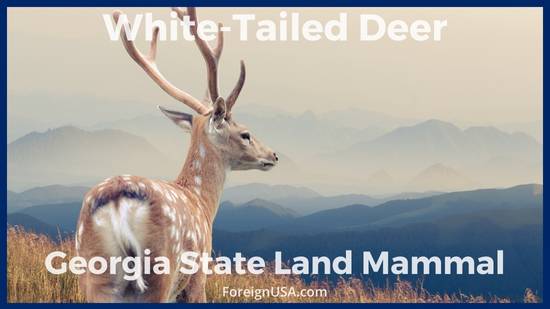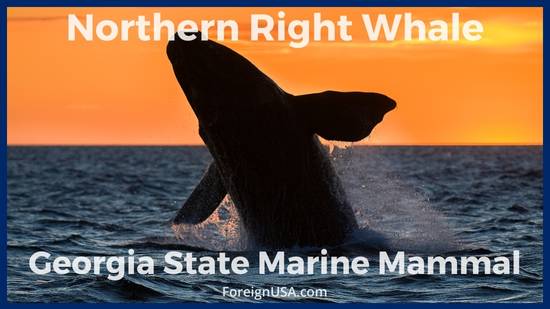A short while after the United States’ independence in 1776, states such as Georgia began to adopt their own official state symbols.
A state symbol can come in the form of state animals, mammals, a state bird and flower, amphibians, nicknames, state seals, and much more.
State symbols were adopted by states to best represent them and their historical roots, and past and present successes. Like all other states, there are many Georgia state symbols.
The Georgia state mammal and Georgia state marine mammal are both the White-Tailed Deer and the Northern Right Whale.

What is the Georgia State Mammal?
Georgia’s official state mammal is the white-tailed deer, which became the official state mammal only in 2015, this was thanks to a group of elementary school students at Reese Road Leadership Academy in Muscogee County.
White-tailed deer are found in abundance all across the state, residing in both forests and coastal marshes.
These beautiful deer take up a reddish-brown appearance in the summer months which turns gray in the winter. The famous name of this deer was derived due to their white-striped tails.
White-tailed deer are able to run at speeds of up to 40 mph and they can also jump 9 feet in the air! Their main food sources are acorns, fruits, mushrooms, and crops like corn, alfalfa, and soybeans.

White-tailed deer typically reside in North America and Southern Canada, where they will travel to and from, passing through Central America.
They can be found all across Southern Canada and the mainland of the United States, reaching as far south as Bolivia! They prefer to live in open woodland but can be found along the outskirts of urban areas and farming countries in search of food.
You will often find them inhabiting areas that run along streams and rivers, woodlands, farmlands, forests, and shrub fields.
Fun Facts About the White-Tailed Deer
Here are some awesome facts about the Georgia state animal that you probably didn’t know about:
- Their large antlers are not for weapons to fight predators, they are used by the males to fight each other during mating season!
- The males will shed their antlers from January to March each year and then re-grow them in the spring.
- The maximum lifespan of these deer is 20 years! However, the average is only 3 years, with some occasionally making it to 10 years old.
- They search for their food during dawn and dusk.
- Their eyesight and hearing are excellent.
- They are fantastic swimmers, and they need to be too! Using their swimming abilities to evade their predators.
- Only the males grow antlers.
- The young deers are called fawns.
- Male deers are called bucks.
- Female deers are called does.
- These deer are the most popular large game animal in the entire nation.
What is the Georgia State Marine Mammal?
Now that we have covered the land mammal that represents Georgia it makes sense to dive into the marine mammal and its significance to the state.
It was in 1985 when Georgia designated the critically endangered northern right whale as the official state marine mammal, before 2015 Georgia only had one state mammal, which was the northern right whale.
The main reason for this symbolic adoption was due to the whale being the only great whale species native to the waters of Georgia.
Around 800 years ago, whalers named it the “right whale”, it was also around this time period that the whale became a threatened species. They were called the “right” whale because they were the right whale to catch, big, slow-moving, and easy to capture.
The hunting of these whales came to a close in the late 1800s. By this point, there were so few right whales left to hunt that it was no longer profitable and today there are sadly only around 350 left in the wild.
Many scientists believe that they will, unfortunately, not escape extinction, despite the fact that hunting them has been illegal for 100 years.
This is due to their wild numbers seemingly not increasing, caused by swimming and resting too close to the surface of the water and often colliding with massive ships.

Fishing nets are extremely hazardous too, and the never-ending pollution in our ocean is stunting the numbers of krill and plankton, that these whales feed off. Not only this, but the females take 3 to 5 years to give birth to just one calf!
These majestic whales will typically grow to around 50 feet (15 meters) in length and can weigh up to 120,000 lbs (54,431 kg)! They are seasoned feeders and filter feed off crustaceans and plankton found in the sea.
When feeding, they tend to swim slowly with their mouth gaping wide to inhale all of the krill and plankton they can. Often, they will consume around 4% of their own body weight per day.
Final Thoughts – What are all the Georgia State Animals?
Despite these two being technically the two official Georgia state animals, there are a few more that have been mentioned in more detail via our main Georgia state symbols page.
However, if you just wanted a brief summary of the other Georgia animal symbols – check them out below:
- Georgia State Amphibian: Green Tree Frog.
- Georgia State Bird: Brown Trasher.
- Georgia State Butterfly: Eastern Tiger Swallowtail.
- Georgia Cold Water Game Fish: Southern Appalachian Brook Trout.
- Georgia State Dog: Adoptable Dog.
- Georgia State Fish: Large Mouth Bass.
- Georgia State Game Bird: Bobwhite Quail.
- Georgia State Insect: Honey Bee.
- Georgia State Reptile: Gopher Tortoise.
- Georgia Saltwater Fish: Red Drum.
Most states will have their symbols showcase a relevant story, indicative of the state and its history, and the Peach State puts its history and what it stands for across very well in its state land and marine mammal.
These interesting facts about Georgia and a whole host of others are what make the state so unique and fascinating to those that live there or are researching the historical events of the state.


